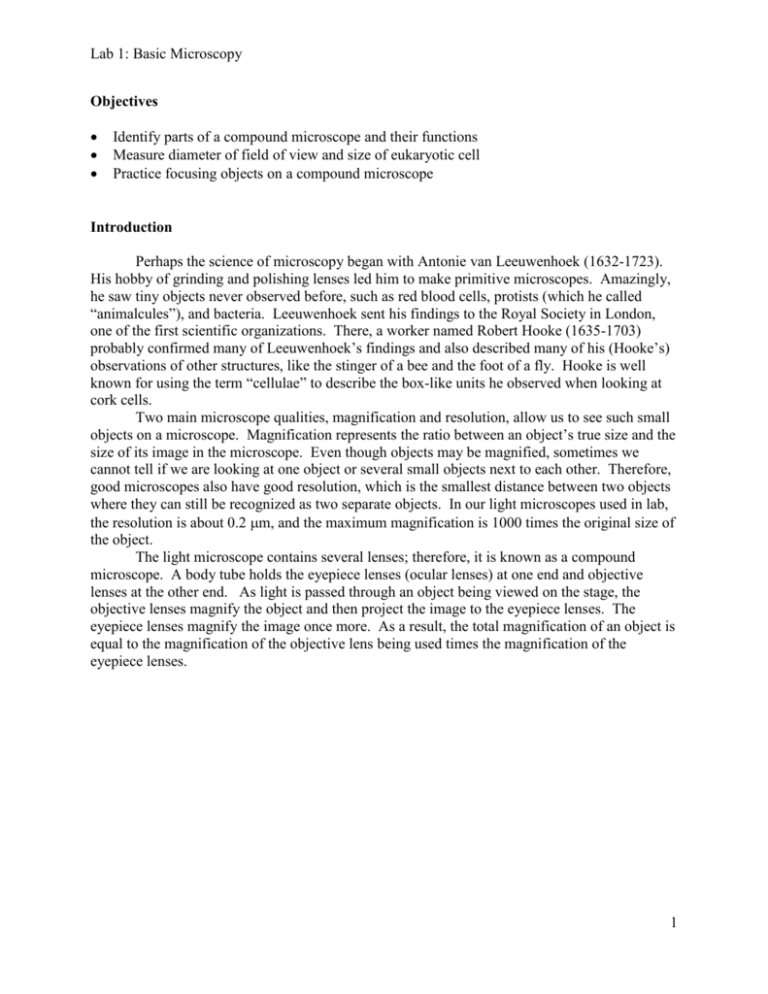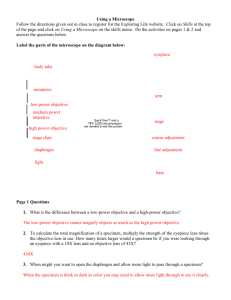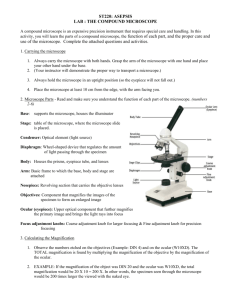Introduction
advertisement

Lab 1: Basic Microscopy Objectives Identify parts of a compound microscope and their functions Measure diameter of field of view and size of eukaryotic cell Practice focusing objects on a compound microscope Introduction Perhaps the science of microscopy began with Antonie van Leeuwenhoek (1632-1723). His hobby of grinding and polishing lenses led him to make primitive microscopes. Amazingly, he saw tiny objects never observed before, such as red blood cells, protists (which he called “animalcules”), and bacteria. Leeuwenhoek sent his findings to the Royal Society in London, one of the first scientific organizations. There, a worker named Robert Hooke (1635-1703) probably confirmed many of Leeuwenhoek’s findings and also described many of his (Hooke’s) observations of other structures, like the stinger of a bee and the foot of a fly. Hooke is well known for using the term “cellulae” to describe the box-like units he observed when looking at cork cells. Two main microscope qualities, magnification and resolution, allow us to see such small objects on a microscope. Magnification represents the ratio between an object’s true size and the size of its image in the microscope. Even though objects may be magnified, sometimes we cannot tell if we are looking at one object or several small objects next to each other. Therefore, good microscopes also have good resolution, which is the smallest distance between two objects where they can still be recognized as two separate objects. In our light microscopes used in lab, the resolution is about 0.2 m, and the maximum magnification is 1000 times the original size of the object. The light microscope contains several lenses; therefore, it is known as a compound microscope. A body tube holds the eyepiece lenses (ocular lenses) at one end and objective lenses at the other end. As light is passed through an object being viewed on the stage, the objective lenses magnify the object and then project the image to the eyepiece lenses. The eyepiece lenses magnify the image once more. As a result, the total magnification of an object is equal to the magnification of the objective lens being used times the magnification of the eyepiece lenses. 1 Lab 1: Basic Microscopy 1.1 Microscope safety, care, and parts 1. 2. 3. 4. 5. ALWAYS carry the microscope with one hand on the base and the other hand on the arm. Use ONLY the BLOWER BRUSH to clean minor dirt and dust from the ocular and objective LENSES. Use ONLY LENS PAPER to clean minor dirt and dust from the slides. ALWAYS put the microscope away with the scanning power objective lens in place, the stage lowered to its lowest point, the cord folded properly and wrapped with the Velcro strap, and the entire microscope covered. Your instructor will review with you the parts of the microscope. Fill in Table 1 to help you remember the parts and their functions. 1.2 Using “e” slide to practice proper microscope procedure 1. 2. 3. 4. 5. 6. 7. 8. 9. 10. 11. 12. 13. 14. With two hands (one hand on the base of scope and the other hand on the arm of scope), obtain a microscope from the appropriate place and place it at your lab station. Remove the microscope cover. The scope should have the following configurations. If the scope needs to be adjusted, please do so. a. The scanning power objective (red) is in place. If it is not, turn the nosepiece to click the scanning power objective in place. b. The stage is as far down as possible. If it is not, turn the coarse adjustment knob to lower the stage as far down as possible. Unwind the wrapped cord and plug into an outlet at your lab station. Turn on the light source using the scroll lever on the base of the microscope. Obtain a letter “e” slide. Put your slide onto the stage. Make sure that the slide is secured properly with the stage clips. Using the mechanical stage control knobs, position the letter “e” in the center of the light. Align the oculars to your eye width so that you can see clearly. As you are looking into the oculars, slowly turn the coarse adjustment knob so that the stage rises slowly. Continue looking into the oculars and moving the coarse adjustment knob until you can see the letter “e.” Focus as best as possible using the coarse adjustment knob. Once you have focused clearly with the coarse adjustment knob, focus with the fine adjustment knob for better clarity. Using the mechanical stage control knobs, position the letter “e” in the center of the field of view. Because microscopes are parfocal, once you have focused the object under the scanning power objective, the object will still be in focus when moving to a higher objective. Now, turn the nosepiece so that the low power objective (yellow) is in place. Don’t worry; the objective will not hit the slide, as long as you had the slide in focus under the scanning power objective. 2 Lab 1: Basic Microscopy 15. Focus further, if necessary, using the fine adjustment knob only. 16. Now, turn the nosepiece so that the high power objective (blue) is in place. Don’t worry; the objective will not hit the slide, as long as you had the slide in focus under the low power objective. Focus further, if necessary, using the fine adjustment knob only. On the QUESTIONS page (question # 3 under 1.2 QUESTIONS), draw how you see the letter “e” under the high power objective. Draw the letter “e” proportional to the field of view. 17. 18. 19. Turn to any objective that you feel comfortable using. With the mechanical stage control knobs, move the slide toward the left side of your body. As you do so, look into the microscope and observe how the image is moving. Record your answer on the QUESTIONS page (question # 4 under 1.2 QUESTIONS). 20. To take the slide off, turn the nosepiece so that the scanning power objective is in place and turn the coarse adjustment knob to lower the stage as far down as possible. Then take the slide off. 21. Remember: always focus first under the scanning power objective using both coarse and fine adjustment knobs, then move to the low power objective, fine focus, and then move to the high power objective and fine focus. 22. We will NOT use the oil immersion objective lens in this class. 3 Lab 1: Basic Microscopy 1.3 Measuring diameter of field of view 1. 2. 3. 4. 5. The field of view is defined as the circle that can be seen through the lenses. The diameter is the length of the field through the center. With the scanning objective lens in place and the stage lowered completely, put a clear plastic ruler on the stage so the millimeter (mm) side of the ruler is visible in the light. As you are looking through the ocular lenses, raise the stage using the coarse adjustment knob until you can see the millimeter markings. Focus as best as possible with the coarse adjustment knob and then fine focus for better clarity. Turn the nosepiece so that the low power objective is in place. Focus with the fine focus only. Note the number of millimeters that you see across the field through the center under the low power objective. You may write here so that you will remember: __________. 6. Convert the above millimeter number to micrometers (m). [1 mm = 1000 m] This value in m is your low power diameter (LPD) of field of view. You may write here so that you will remember: __________. 7. Calculate the high power diameter of field of view (HPD) by using the following formula: HPD = LPD (in m) x (LPM / HPM) where LPM = low power total magnification HPM = high power total magnification The answer is in m. Record this answer on the QUESTIONS page. You will need this number for the next procedure. 8. Turn the nosepiece so that the scanning power objective is in place and turn the coarse adjustment knob until the stage is lowered completely, and then take the ruler off the stage. 4 Lab 1: Basic Microscopy 1.4 Figuring the size of one cork cell 1. 2. 3. 4. 5. 6. 7. 8. 9. 10. 11. Just like Robert Hooke, you will observe cork cells. Cork is the outer bark of a Mediterranean tree called the cork oak. Obtain a cork slide. With the scanning objective lens in place and the stage lowered completely, secure the cork slide with the stage clips on the stage. Using the mechanical stage control knobs, position the slide so that the cork is visible in the light. As you are looking into the oculars, raise the stage with the coarse adjustment knob until you can see the cork. Focus with the fine adjustment for better clarity. Make sure the cork is in the center of the field of view. Turn the nosepiece so that the low power objective is in place. Fine focus only. Turn the nosepiece so that the high power objective is in place. Fine focus only. Select one row of cork cells that cross through the center of the field of view. Count how many cells are in this row. You will calculate the size of one cork cell by using the following equation: HPD (in m) / # cork cells across the field = size of one cork cell in m Record your answer on the QUESTIONS page. Turn the nosepiece so that the scanning power objective is in place and turn the coarse adjustment knob until the stage is lowered completely, and then take the slide off the stage. 1.5 Practicing microscope procedures with sample slides 1. 2. 3. 4. 5. Choose three different slides from the slide box. All slides should be viewed under the high power objective. However, if you choose to observe a chicken embryo, look at it ONLY under the scanning power objective. Use proper microscope procedures to view each slide. That is, always focus first under scanning power objective, and then move to higher objectives and fine focus. If you are a poor artist and feel that the instructor would not be able to identify the object from your drawing, please call the instructor over to look into the scope and confirm that you have viewed the object under the microscope. Draw your images on the QUESTIONS page. 1.6 Completing Microscope Checklist 1. Before leaving, complete the Microscope Checklist to prepare the scope for the next lab. Also, ask the instructor to initial your checklist and look at your scope before you put the scope away. 5 Lab 1: Basic Microscopy Table 1. Microscope parts and functions. Structure Function Arm Base Eyepiece lenses (ocular lenses) Magnifying power alone? Body tube Nosepiece Scanning power objective lens (red) Low power objective lens (yellow) High power objective lens (blue) Magnifying power alone? Total magnification of object when in use? Magnifying power alone? Total magnification of object when in use? Magnifying power alone? Total magnification of object when in use? Stage Stage clips Coarse adjustment knob Fine adjustment knob Mechanical stage control knobs Diaphragm control lever Light source 6 Lab 1: Basic Microscopy 1.2 QUESTIONS 1. No matter if your goal is to make final observations of an object under scanning, low, or high power objective, you must ALWAYS focus the slide first under which objective lens? Which adjustment knobs should you use to focus the object when using this objective lens? 2. When you switch to the low power objective lens, which adjustment knob should you use ONLY? Also, when you switch to the high power objective lens, which adjustment knob should you use ONLY? 3. Draw how you see the letter “e” under the high power objective. Draw the letter “e” proportional to the field of view. a. What is the total magnification of this “e” under the high power objective lens? 4. When the slide is moving toward the left side of your body, which way does the image move as you look at the image in the scope? 5. Suppose the letter “e” on your slide were oriented like before looking into the scope. After placing this slide on the stage and focusing the image in the scope, draw how the image would appear in the scope under the scanning or low power objective lens. 1.3 QUESTION 6. Record the high power diameter of field of view in µm. If you would like to ask instructor to make sure you are on the right track, please do so now because the next question depends on this number. 7 Lab 1: Basic Microscopy 1.4 QUESTIONS 7. What is the size of one cork cell in µm? 8. Cells are classified as either eukaryotic or prokaryotic. Only bacteria and archaea have prokaryotic cells. All other living things contain eukaryotic cells. a. Which cell is bigger, eukaryotic or prokaryotic? b. What is the approximate size range (in µm) for a prokaryotic cell? The figure on p. 62 may help. Compare this number to the size of the eukaryotic cork cell. 1.5 QUESTIONS 9. Drawing of sample slides. All slides must be viewed under high power (400 X total magnification), except for the chick embryo, which should be viewed under the scanning power. If you are not a good artist, please ask instructor to view object under the scope before you draw. Object: Total magnification: Object: Total magnification: Object: Total magnification: 1.6 QUESTION 10. Did you complete the Microscope Checklist and asked your instructor to initial the Checklist and look at your scope before putting the scope away? HAND IN ONLY THE QUESTIONS PAGES (7-8) AND THE MICROSCOPE CHECKLIST. 8







